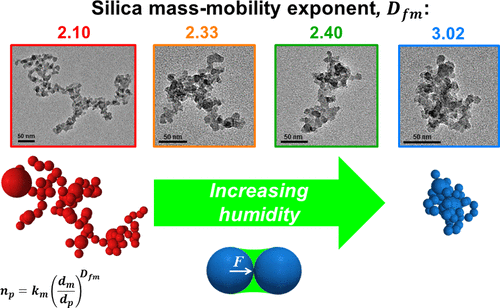Our official English website, www.x-mol.net, welcomes your
feedback! (Note: you will need to create a separate account there.)
Impact of Humidity on Silica Nanoparticle Agglomerate Morphology and Size Distribution
Langmuir ( IF 3.7 ) Pub Date : 2018-06-26 00:00:00 , DOI: 10.1021/acs.langmuir.8b00576 Georgios A. Kelesidis 1 , Florian M. Furrer 1 , Karsten Wegner 1 , Sotiris E. Pratsinis 1
Langmuir ( IF 3.7 ) Pub Date : 2018-06-26 00:00:00 , DOI: 10.1021/acs.langmuir.8b00576 Georgios A. Kelesidis 1 , Florian M. Furrer 1 , Karsten Wegner 1 , Sotiris E. Pratsinis 1
Affiliation

|
The effect of humidity on flame-made metal oxide agglomerate morphology and size distribution is investigated, for the first time to our knowledge, and compared to that on soot, which has been widely studied. Understanding the impact of humidity on such characteristics is essential for storage, handling, processing, and eventual performance of nanomaterials. More specifically, broadly used agglomerates of flame-made silica nanoparticles are humidified at various saturation ratios, S = 0.2–1.5, and dried before characterization with a differential mobility analyzer (DMA), an aerosol particle mass (APM) analyzer, and transmission electron microscopy. At high humidity, the constituent single and/or aggregated (chemically bonded) primary particles (PPs) rearrange to balance the capillary forces induced by condensation–evaporation of liquid bridges between PPs. Larger agglomerates restructure more than smaller ones, narrowing their mobility size distribution. After humidification at S = 1.5 and drying, agglomerates collapse into compact structures that follow a fractal scaling law with mass–mobility exponent Dfm = 3.02 ± 0.11 and prefactor km = 0.27 ± 0.07. This critical S = 1.5 for silica agglomerates is larger than the 1.26 obtained for soot because of the hydrophilic surface of silica that delays water evaporation. The relative effective density, ρeff/ρ, of collapsed agglomerates becomes invariant of mobility diameter, dm, similar to that of fluidized and spray-dried granules. The average silica ρeff/ρ = 0.28 ± 0.02 is smaller than the 0.36 ± 0.04 measured for the humidified-dried soot because of the larger size of silica aggregates, dm/dp, and number of constituent primary particles, np, of diameter dp. This is verified by tandem-DMA (TDMA) measurements, yielding maximum dm = 3dp or 5dp and np = 13 or 36 for the soot or silica aggregates studied here, in good agreement with those reported from microscopy and high-pressure agglomerate dispersion. A scaling law relating the initial dm,o to dm, Dfm, and km after condensation-drying is developed. The mass–mobility relationship of collapsed silica and soot agglomerates obtained by combining this law with fast TDMA measurements is in excellent agreement with that measured by the direct, but tedious, DMA-APM analysis.
中文翻译:

湿度对二氧化硅纳米颗粒附聚物形态和尺寸分布的影响
据我们所知,首次研究了湿度对火焰状金属氧化物附聚物形态和尺寸分布的影响,并将其与烟灰进行了比较,而烟灰已被广泛研究。了解湿度对此类特性的影响对于纳米材料的存储,处理,加工以及最终性能至关重要。更具体地,以各种饱和比S将湿润的火焰状二氧化硅纳米颗粒的广泛附聚物加湿。= 0.2–1.5,干燥,然后用差示迁移率分析仪(DMA),气溶胶颗粒质量(APM)分析仪和透射电子显微镜表征。在高湿度下,组成的单个和/或聚集(化学键合)的初级粒子(PP)会重新排列,以平衡由PP之间的液桥的冷凝-蒸发所引起的毛细作用力。较大的团聚体比较小的团聚体更能重组,从而缩小了其流动性的大小分布。在S = 1.5的加湿条件下干燥后,团聚体坍塌成紧凑的结构,遵循分形标度定律,质量迁移率指数D fm = 3.02±0.11,预因子k m = 0.27±0.07。这个关键的S对于二氧化硅附聚物而言,= 1.5大于对于烟灰获得的1.26,这是因为二氧化硅的亲水性表面会延迟水的蒸发。坍塌附聚物的相对有效密度ρeff /ρ变为流动性直径d m的不变性,类似于流化和喷雾干燥的颗粒的密度。平均二氧化硅ρeff /ρ= 0.28±0.02小于加湿干燥烟灰的测量值0.36±0.04,这是因为二氧化硅聚集体d m / d p较大,并且构成的初级粒子数n p较大,直径d p。这已通过串联DMA(TDMA)测量得到验证,对于此处研究的烟灰或二氧化硅聚集体,最大d m = 3 d p 或5 d p,n p = 13或36,与显微镜报道的结果高度吻合,并且压力团聚体分散体。与初始d m,o到d m,D fm和k m相关的缩放定律进行冷凝干燥后。通过将此定律与快速TDMA测量相结合获得的坍塌二氧化硅和烟灰团聚物的质量迁移率关系与直接但乏味的DMA-APM分析所测得的关系极佳。
更新日期:2018-06-26
中文翻译:

湿度对二氧化硅纳米颗粒附聚物形态和尺寸分布的影响
据我们所知,首次研究了湿度对火焰状金属氧化物附聚物形态和尺寸分布的影响,并将其与烟灰进行了比较,而烟灰已被广泛研究。了解湿度对此类特性的影响对于纳米材料的存储,处理,加工以及最终性能至关重要。更具体地,以各种饱和比S将湿润的火焰状二氧化硅纳米颗粒的广泛附聚物加湿。= 0.2–1.5,干燥,然后用差示迁移率分析仪(DMA),气溶胶颗粒质量(APM)分析仪和透射电子显微镜表征。在高湿度下,组成的单个和/或聚集(化学键合)的初级粒子(PP)会重新排列,以平衡由PP之间的液桥的冷凝-蒸发所引起的毛细作用力。较大的团聚体比较小的团聚体更能重组,从而缩小了其流动性的大小分布。在S = 1.5的加湿条件下干燥后,团聚体坍塌成紧凑的结构,遵循分形标度定律,质量迁移率指数D fm = 3.02±0.11,预因子k m = 0.27±0.07。这个关键的S对于二氧化硅附聚物而言,= 1.5大于对于烟灰获得的1.26,这是因为二氧化硅的亲水性表面会延迟水的蒸发。坍塌附聚物的相对有效密度ρeff /ρ变为流动性直径d m的不变性,类似于流化和喷雾干燥的颗粒的密度。平均二氧化硅ρeff /ρ= 0.28±0.02小于加湿干燥烟灰的测量值0.36±0.04,这是因为二氧化硅聚集体d m / d p较大,并且构成的初级粒子数n p较大,直径d p。这已通过串联DMA(TDMA)测量得到验证,对于此处研究的烟灰或二氧化硅聚集体,最大d m = 3 d p 或5 d p,n p = 13或36,与显微镜报道的结果高度吻合,并且压力团聚体分散体。与初始d m,o到d m,D fm和k m相关的缩放定律进行冷凝干燥后。通过将此定律与快速TDMA测量相结合获得的坍塌二氧化硅和烟灰团聚物的质量迁移率关系与直接但乏味的DMA-APM分析所测得的关系极佳。











































 京公网安备 11010802027423号
京公网安备 11010802027423号